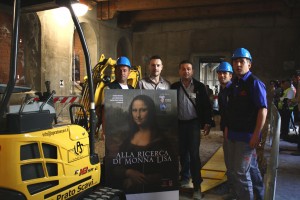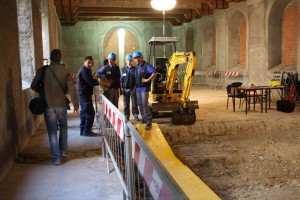The mystery surrounding the subject of the world’s most famous painting may be close to being solved with a little help from a New Holland E18SR rotating mini-excavator and a C175 compact tracked mini-shovel.

Were it not for the hypnotic powers of the legendary smile and the resulting worldwide success of an all-time best seller, it would be little more than a simple historical curiosity or a scholarly pursuit.
When the tattered death certificate that indicated Lisa’s burial site was found in 2007 in the St. Lawrence Basilica of the Florentine convent of Sant’Orsola, the world looked on with baited breath.
Inevitably, amidst everyone’s burning curiosity, the order was given to begin excavation work to recover the body. By carefully recovering the remains with special attention to the skull, a computerised portrait of the woman’s face will be created and compared with the portrait in the masterpiece housed in the Louvre, prior to comparison with the DNA of the remains of the Gherardini children buried in another Florentine church.
The very first investigations were conducted with Georadar that verified the presence of relics up to a depth of 3-4 metres in the two cloisters and in a church of the former Florentine convent.
This is where the New Holland Construction equipment excavator with hammer came into clear away a 36 centimetre layer of reinforced concrete put down in the1980’s for building a
The New Holland mini excavator conducted precision excavation within the walled niches containing cemetery urns (known as loculi) in which the Surintendence had determined that no relics of archaeological interest would be found. In those loculi in which they thought remains might be present, the Prato firm proceeded by hand. The excavator meanwhile remained at the ready to be able to remove the earth that was loaded with the shovels into the bucket and brought to the edge of the digs.
The mini excavator was also chosen for its variable (98-132 mm) track and working clearance of 2120 mm that enables operation in very tight spaces without worrying about what may happen behind, thanks to a rear rotating radius of zero. This is ideal for being able to move with no problems within the historical building.
Andrea Toparelli, proprietor of La Prato Excavation told us that, “the first day, surrounded by so many telephoto lenses and television cameras from all over the world, we were all quite excited. But everything went off just fine, since the equipment is highly sensitive and responds perfectly to the operator’s commands, working inside of even such a tight space as the loculi was a piece of cake. As a precautionary measure we used a bucket without teeth to proceed as delicately as possible.” The C175 compact tracked mini-shovel, equipped with an exclusive kinematic Superboom for easy loading of lorries, was also present on the worksite for removing the excavation heap.
The team of eight operators from the Prato firm, under the guidance of the Tuscany Archaeological Superintendence will be involved inside the former church for approximately one month for the purpose of bringing up to the light of day the two entire burial vaults that are emerging from beneath the ground.
The relics found will be analysed to determine whether they are truly the remains of the Lady who offered her face to the Mona Lisa and perhaps solve the mystery once and for all.

Source: CNH Press Room
Latest Events News
- NordBau 2024: Construction machinery, construction equipment, commercial vehicles in construction and a Northern European congress on housing construction and heating transition
- INTERMAT 2024: the low carbon theme also at the heart of the show to improve its environmental performance
- Liebherr’s R 972 crawler excavator presented at the Intermat show
- Volvo moves to zero with decarbonization showcase at Intermat 2024
- Komatsu at Intermat 2024